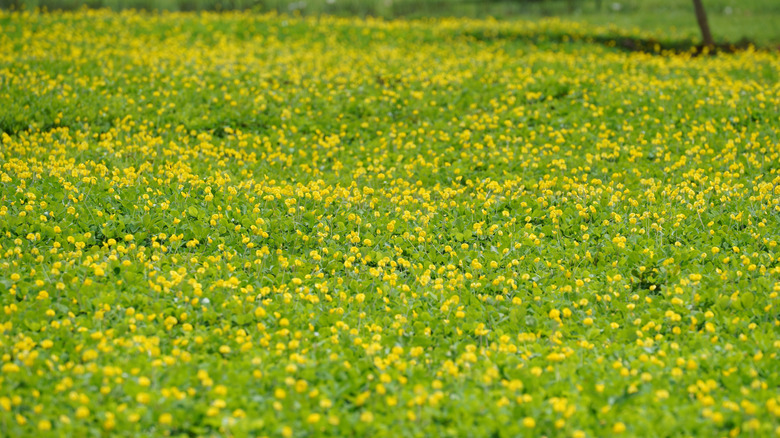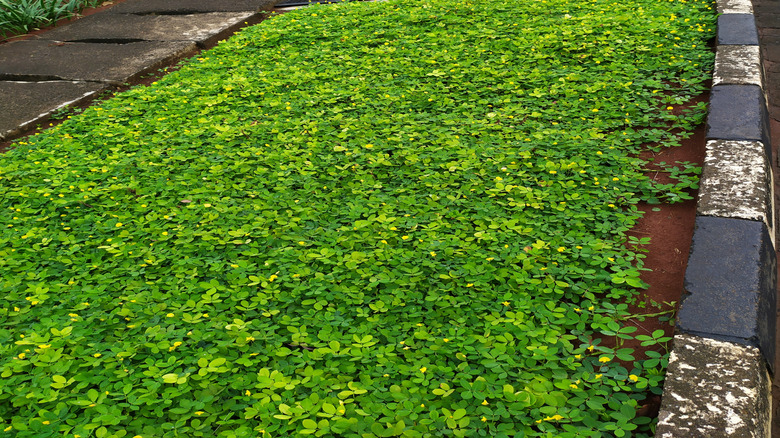How To Tackle Common Problems When Growing Perennial Peanut As A Grass Alternative
One of the best methods for mowing your lawn more efficiently is to stop mowing altogether. Coincidentally, that's one of the benefits of planting your yard with perennial peanut (Arachis glabrata) instead of turfgrass. Native to northern Argentina and Peru, the plant was released for landscaping in the warmest parts of the U.S. (USDA Plant Hardiness Zones 8B to 11) in the 2010s. Since then, it's become popular with people looking for a fast growing, drought and pest hardy, undeniably pretty, and pollinator friendly lawn alternative.
Perennial peanut isn't all springy foliage and pretty blooms, however. Problems encompass everything from a dislike of cold, shade, and damp to fast-spreading rhizomes to the plant struggling under heavy feet and losing out against weeds. Tackling these issues requires preparing the ground properly for planting, keeping a close eye on watering needs, and incorporating paving and edging into your landscaping.
You can walk on a perennial peanut lawn, but the plant doesn't tolerate heavy use, like boisterous play by pets or children, as well as turfgrass. And that may well matter a lot to those looking to use it as a lawn replacement. It can also be tricky to get perennial peanut's water needs right. Though the plant tolerates drought conditions once mature, it needs substantial irrigation while putting down roots in a new site. Contrarily, it hates boggy conditions and extended periods of rain. Finally, while perennial peanut isn't considered invasive, each plant boasts a rhizomatic root system full of deeply embedded, adventurous underground tendrils. If you're not watching, your patch can spread quickly to areas you don't want it, like your flower or vegetable beds.
Perennial peanut problem workarounds for a lush lawn
This hardy plant needs sun, so it's no good for deeply shaded backyards, and it goes dormant once frosts appear, looking decidedly unsightly until it resprouts again until the following spring — or not at all in cold climates. Finally, perennial peanut just isn't that great at weed suppression; the soft, fluffy growth lets in just enough light for hardy weed species. Plus, the plant is sensitive to common herbicides, including bentazon, clopyralid, glufosinate, glyphosate, sulfosulfuron, and imazaquin, so these can't be used to treat weeds.
Still want to replace your grass with this flowering ground cover for a lawn full of color? Sinking stepping stones into or creating paths through well-trodden areas will help keep people off your sensitive perennial peanut lawn. You could also inter-plant it with a sturdy turfgrass. Before planting perennial peanut, remove all plants from the area and kill weeds with a nonselective herbicide. Apply a pre-emergent herbicide to destroy weed seeds and add a layer of mulch.
Plant perennial peanut in good draining soil and irrigate recently planted sod vigorously. If your lawn looks lackluster after a dry spell, water deeply to reactivate those hardy rhizomes. Spreading a little too vigorously? Contain perennial peanut with plastic, fiberglass, metal, or concrete edging. If you find your perennial peanut lawn doesn't bounce back well — or at all — after winter, consider growing it as a warm season annual and sow rye grass for winter cover. Since sun-loving perennial peanut really isn't a stunning lawn alternative for your shady backyard, you'll either need to remove whatever is shading your yard or choose a different lawn alternative.

